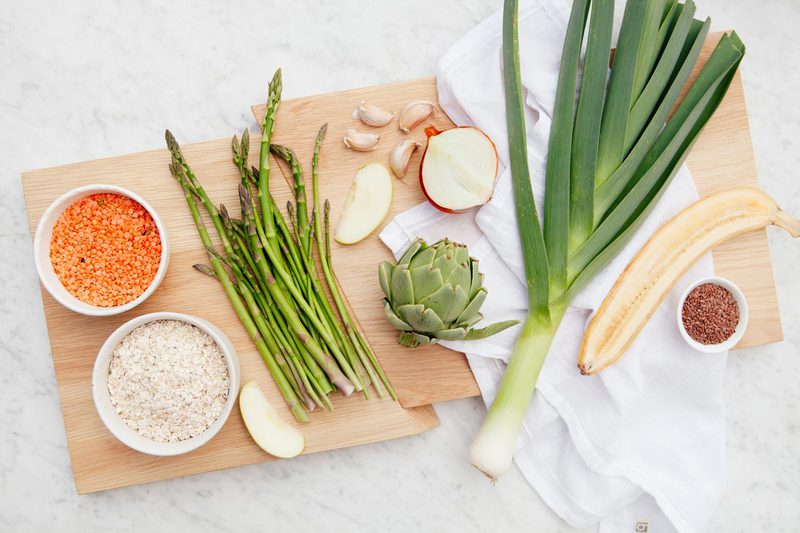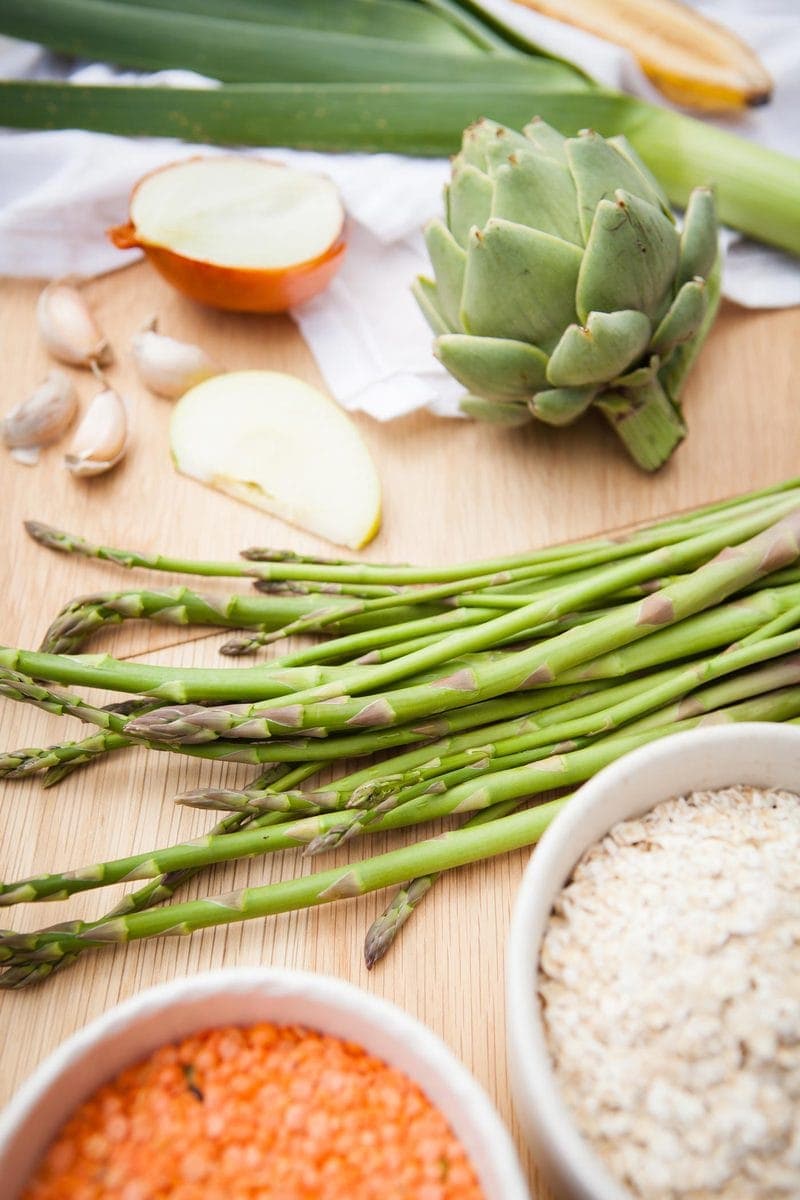
This post is one of two posts on this topic. The second post will look at my favourite prebiotic foods in detail.
We hear a lot about probiotics – but what about prebiotics? They’re just as deserving of attention because they play such an important role in our health. Prebiotics are certain types of fibres found widely in different foods – the most-researched types being fructo-oligosaccharides (FOS), inulin and galacto-oligosaccharides (GOS). Lactulose, a synthetic sugar used as a laxative, is also well-studied as a prebiotic.
Some examples of FOS and inulin include artichokes, banana, barley, chicory root, dandelion, garlic, leeks, yacon and wheat. Milk, yoghurt and legumes are examples of GOS.
Prebiotics are needed to maintain a healthy colonic and mucosal microflora. Put simply, they provide food for beneficial bacteria (such as lactobaccili and bifidobacteria) due to fermentation, and to mucosal cells indirectly via the by-products of fermentation, with the net effect of promoting health and well-being.
Some may experience mild gastrointestinal discomfort after eating FOS and GOS rich foods, such as gurgling noises, bloating and flatulence – but these usually abate as the microflora adjusts. These effects may be more pronounced in those with irritable bowel syndrome or FODMAP sensitivities.
Finally, when prebiotics are taken together with probiotics they are referred to as synbiotics, as they have such a valuable synergy. This was a term coined for commercially prepared products, however artful food combining can give you the same results. Think prebiotic oats with probiotic yoghurt, or prebiotic rich beans with a side of probiotic rich sauerkraut.
[bctt tweet="Prebiotics: food for the good bugs in your gut! Read more on the health benefits here."]
Introduction
Prebiotics have been defined as “non-digestible food ingredients that beneficially affect the host by selectively stimulating the growth and/or activity of one or a limited number of bacteria in the colon, thus improving host health” [1]. Whilst prebiotics are types of fibre, not all types of fibre are prebiotic:
- They must pass through the stomach and small intestine intact, resisting gastric acidity, breakdown and absorption, until they reach the colon
- Upon reaching the colon, they must be selectively fermented by potentially beneficial bacteria, whilst being ignored by pathogenic bacteria
- They must positively change beneficial microflora – stimulating their growth and activity, and lastly,
- Positively affect the intestinal lumen, to promote health
Some of the various types of fibres that fit the above criteria include;
- Fructo-oligosacchardies (FOS)
- Inulin
- Galacto-oligosaccharides (GOS)
- Beta glucans
- Pectin
- Resistant starch’s
The beneficial bacteria they are selectively fermented by include the bifidobacteria and lactobacilli genus – both are lactic acid producing [4].
Literature suggests the ideal daily dosage of prebiotics is 10g/day, with dosages less than 3g/day unlikely to stimulate growth of beneficial lactic acid bacteria. Americans seem to be consuming prebiotics in the range of 1-4g/day. Interestingly, inflammatory bowel disease develops in parts of the world where daily intake of prebiotic fibre is low [5].
Prebiotics have a plethora of health-promoting effects...
Food for good bacteria
First and foremost – prebiotics provide food for probiotics. Energy is liberated from these fibres via anaerobic fermentation. Once this colony of beneficial microflora is stimulated, happy and flourishing, they can benefit our health in numerous ways: they keep bad bacteria from adhering to the gut wall, produce nutrients, increase bowel transit time, contribute to immune health, and create an energy source for the cells of the colon, via by-products made during fermentation [6]. Some of these points will be elaborated on below.
Fun fact: the number of bacteria in our gastrointestinal tracts outnumber our own cells by 100-fold!
Resistance to pathogenic bacteria is enhanced
With a flourishing community of beneficial lactic acid producing bacteria, pathogenic bacteria are ‘crowded out’. How? Good bacteria such as Lactobacillus and Bifidobacterium adhere to cells in the intestinal wall, preventing the binding of bad bacteria such as Salmonella and Escherichia coli [7, 8].
Prebiotics help correct dysbiosis
Dysbiosis is a term used to describe alterations in intestinal microflora, and abnormal colonic fermentation, creating an environment where potentially pathogenic bacteria can flourish. Factors that can alter this delicate balance include stress, poor diet, antibiotic and drug use. Prebiotics and probiotics together (as synbiotics) may help normalise these alterations [9].
Production of short-chain fatty acids increases
As these beneficial bacteria are busy fermenting (digesting) our prebiotic fibres, they create various gases and by-products such as the short chain fatty acids (SCFAs) – acetate, propionate and butyrate. These SCFAs provide an energy source for the cells of the colon wall, and promote a low pH (acidic) environment favourable to beneficial microbes and despised by pathogenic bacteria [10].
Other important functions include the modulation of electrolyte and water absorption, and activation of the immune and inflammation response. In fact, alterations in the number of SCFAs in the bowel have been seen in conditions such as cancer, inflammatory bowel disease and diabetes [11].
There is some evidence to suggest that intake of SCFAs have a positive effect on the treatment and management of ulcerative colitis and Crohn’s disease [12, 13, 14].
Additionally, SCFAs directly stimulate peristalsis – that is, they help promote healthy bowel movements [15].
More mucin is produced
Mucins are a component of mucus: secreted by goblet cells in the intestinal wall, they form a mechanical barrier to protect against pathogens, toxins, dehydration and abrasion from luminal contents. Prebiotic fibres feed the health-promoting Lactobaccillus plantarum 299v and Lactobacillus rhamnosus GG, which in turn up-regulate production of mucin [16].
Prebiotics may modulate the immune system
Our gastrointestinal tracts are home not only to a diverse microflora, but also to a huge amount of immune cells. Gut-associated lymphoid tissue (GALT) represents close to 70% of the immune system [17].
Although somewhat scarce, literature suggests that prebiotics may have the ability to positively affect immune response, resulting in an increased resistance to infection and prevention of allergic conditions such as food allergy, asthma and eczema.
For example, clinical trials have shown that supplementation with prebiotics in infant formula protects against infection during the first six months of life [18]. And a Cochrane review found some evidence that infants fed prebiotics may prevent eczema for up to two years. It is believed that promoting the growth of beneficial bacteria in the colon may prevent sensitisation to foods [19].
Absorption of minerals is enhanced
With a thriving colony of beneficial bacteria, there is increased competition with pathogenic microbes for nutrients [20]. Consequently, there appears to be an enhanced absorption of minerals such as calcium and magnesium [21].
Summary
Prebiotics are naturally widespread in our food supply and provide food for the beneficial bacteria (probiotics) in our gastrointestinal tract, and indirectly, for the cells of the mucosa. They contribute to gut and immune health, and have reported benefits in treating and managing digestive disorders such as inflammatory bowel disease. Prebiotics in whole foods are safe to consume though may cause mild gastrointestinal distress if taken in excess.
Check back in a few days’ time – I have part two of this post on the way – my top ten prebiotic rich foods and how to prepare them to maximise prebiotic content!





Sarah | Well and Full
This is such an informative article, thank you for sharing! I definitely feel motivated to add more prebiotics into my diet 🙂